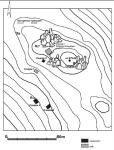Summary (English)
ARCHAEOLOGICAL EXPLORATIONS NEAR THE VILLAGE OF DOLNO DRYANOVO (Anelia Bozhkova – aneliabozkova@yahoo.com, Nadezhda Todorova) The site is located on a steep hill. Due to clandestine digs, rescue excavations were conducted. Seven sondages and two trenches were carried out on a total area of 65 sq. m. Fragmentary tegulae and sherds of the 4th – beginning of the 3rd centuries BC were found all over the site. Piles of stones from this period were documented in two sondages. The piles were associated with a layer up to 1 m thick, containing fragmentary tegulae, sherds, animal bones, loom weights, terracotta spindle whorls and fragments from a terracotta pyraunos. Probably, the piles were deposits for votive gifts. A layer, 30 – 50 cm thick, containing materials from the final phase of the Late Chalcolithic period (4200 – 3800 BC) was documented in sondages Nos. 2, 4 and 6. Piles of burned wall plaster, sherds and uneven stones were discovered. The finds include three flint tools, a terracotta loom weight and a flat anthropomorphic figurine. The Late Chalcolithic pottery is technologically and typologically homogenous. The shapes include dishes, bowls, amphorae, pots, cups, lids and small vessels. The decoration is incised, pricked, stamped and painted with graphite and mineral paints. The decoration painted with graphite is geometric and the motives are predominantly linear. There is an interesting group of asymmetrical pots decorated with painted graphite lines, combined with fields filled with red hematite paint and garland-like motifs imitating impressions with cord. The site was probably related to cult practices during the Late Chalcolithic period and the Late Iron Age.
- Anelia Bozhkova - Archaeological Institute with Museum
- Nadezhda Todorova - Department of Archaeology, Sofia University St. Kliment Ohridski
Director
Team
Research Body
- Archaeological Institute with Museum
- Sofia University St. Kliment Ohridski






![Download [PDF]](/excavation/skins/fasti/images/results/download_sml.png)